A detailed guide to Teamfight Manager, including champion analysis, team composition suggestions, and some tips on drafting and analysis
Introduction
I’ve noticed a lot of confusion around the game mechanics in the discussion forum and reviews for this game, so I figured I’d throw together some thoughts on how to proceed. Below I’ve laid out my analysis for each of the champions in the game, some hints and tips for drafting, and some general-purpose team comps to consider. But before we begin…
Disclaimers!
SPOILERS! If you’re not too far into the game yet, you’ll see some champions listed that you haven’t had unlocked yet, and some formats as well. The game has little to no plot, so that’s all the spoilers.
PATCHES! The game applies content patches at the midpoint and endpoint of each season. These seem to be at least partially based on the winrates of each champion, but the exact mechanics I haven’t nailed down yet. Regardless, this will mean the below can only guide you so far – I have no way of anticipating if one champion gets buffed eight times in a row on your save and becomes the meta-definer.
HUMOUR! In a few places in this guide, I try to be funny. I generally fail in this lofty goal. Just ignore me when I start trying to entertain you and I’ll get back on topic sooner or later.
Glossary
The below are some terms I tend to use, as a MOBA player and analyst. I have defined them, so you can follow along too.
ADC – A long-range damage dealer that focusses on dealing damage with basic attacks. Usually have little or no team utility. An abbreviation of Attack Damage Carry, a MOBA term.
AoE – Area of effect, i.e. attacks which hit multiple targets at once.
Assassin – A champion who tries to bypass the frontline in order to kill backline champions. Usually have high damage output and low survivability, which they make up for by killing everything that’s trying to kill them.
Backline – A team’s ranged contingent, whether they be ADCs, mages, healers, or anything else that wants to be protected to fight from a distance.
Bruiser – Interchangeable with fighter, warrior etc., a melee champion who both soaks damage and deals it, but neither as effectively as a champion dedicated to one role.
CC – Crowd Control, i.e. an ability which stops an enemy from acting.
Frontline – Melee champions who move to the front during a fight. The nature of melee champions means they’re going to be soaking damage before your backline is (unless the enemy team is primarily comprised of assassins, anyway).
Comps – Compositions, i.e. groups of champions that create a strategy when chosen together.
Dive – The act of rapidly approaching an enemy backline, ignoring their frontline. This is the hallmark of assassins, and is usually a one-way trip, leaving the diver to deal as much damage as they can before they’re shut down by the inevitable respawns.
Lifesteal – An effect which heals a champion as they deal damage, usually from basic attacks. The healing is usually based on the damage dealt.
Peel – Forcing an enemy champion to disengage from attacking one of your champions. For example, if Knight taunts a Ninja attacking your Priestess, he has peeled for her.
Pick/Ban – A very high priority, usually meta-defining champion; If you’ve got first pick on the draft, don’t ban it; the opponent will either use one of their own bans or let you take it in the first pick. If you’re second pick, always ban it, because the risk of the opponent getting it is too high. Swordsman is a great example of this at the start of the game.
Release X – This refers to a champion as they are when they’re first introduced into the game; for example, ‘Release Swordsman is very strong’. I phrase it this way to specify that the champion is only strong so long as they haven’t been gutted by patches.
Squishy – Champions with low defences, easily killed if subjected to damage.
Tank – Champions with good defensive abilities and stats, but little or no offensive capability. Their role is simply to soak damage while their team dishes it out.
Champions
The following is the template I will be using for my analysis of each champion. Note that I’m listing them in the order the game does, which if I recall correctly is release order.
Name: The name of the champion. Obviously. If you needed me to tell you that, you may be beyond help.
Role: The role the champion tends to play. Important note – I use my own roles rather than those the game assigns, as I feel they’re more useful from an analysis point of view. Most of them are the same anyway.
Analysis: The main meat of the analysis. Avoid if vegetarian.
Counters: The champions this champion counters. Note that just because I don’t list any counters doesn’t mean the champion is bad – it just means there aren’t specific champions that they shut down.
Countered by: The inverse of the counters above.
Suggested comps: Team comps that this champion works well in. Again, just because I don’t list anything here doesn’t mean the champion is bad – they just don’t have a very obvious comp to be picked into. Often this means they’re situational picks, or (like Knight) broadly strong enough to be picked in most of them.
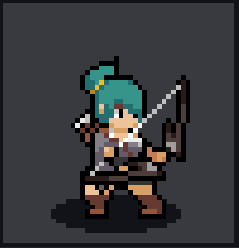 Years of archery from a crouching position have given her phenomenal precision, agility, and some thicc thighs. I mean damn. – Author
Years of archery from a crouching position have given her phenomenal precision, agility, and some thicc thighs. I mean damn. – Author
Name: Archer
Role: ADC
Analysis: The only ADC unlocked at the start of the game, Archer is the most defensive of the ADCs. Her ability gives her some minor self-peel, though this isn’t entirely reliable (she’ll only cast it if she’s targeting her attacker, so some player traits can make it useless). Her ult is simply a barrage of arrows which deal decent, but not incredible, damage.
Archer is an extremely situational pick; her damage is acceptable, but she isn’t going to carry a team, and while she can protect herself to an extent she’ll still need to support to escape a diving Ninja. She can work well when paired with another good single-target damage dealer like Sniper or Necromancer, or as a relatively safe backline pick against a team with a Ghost or Vampire (though, again, not a Ninja).
Generally a staple pick in the initial 2v2 season, but loses relevance after that to become a very situational pick.
Counters: None (though favoured against assassins)
Countered by: None
Suggested comps: Paint-By-Numbers
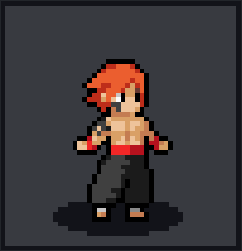 Yeah, my name’s Fighter. ‘Cause I fight things, see? What else would I be called? – Fighter
Yeah, my name’s Fighter. ‘Cause I fight things, see? What else would I be called? – Fighter
Name: Fighter
Role: Bruiser
Analysis: One of the two bruisers unlocked at the start of the game, and decidedly the weaker one. Fighter’s ability repositions his target while stunning them for the duration; unfortunately its low damage and requirement for him to be in melee range of the target makes it rather underwhelming, as it tends to be burned on tanks who don’t really care about being CC’d.
His ult is a fairly sizeable AoE, with respectable damage and a short-duration knock-up effect.
Fighter is a pretty beefy champion who can take the place of a dedicated tank so long as he’s not expected to eat a lot of damage. Unfortunately, as game sizes rise, situations where he’s not going to soak more than one attacker’s damage at a time become increasingly rare. His niche is to CC other melee, which in theory is a solid one; in practice, however, when melee damage dealers are relevant (i.e. when Swordsman is strong) he still winds up getting outdamaged by them, and when they’re not relevant, neither is he.
The only time I would recommend drafting Fighter is when the enemy team has only a single, relatively squishy melee, or against teams with no frontline and multiple assassins.
Counters: None
Countered by: None
Suggested comps: None
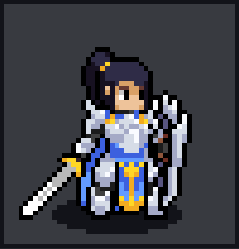 My plate armour and mighty shield protect me from- my head? No, helmets are for sissies. Obviously. – Knight
My plate armour and mighty shield protect me from- my head? No, helmets are for sissies. Obviously. – Knight
Name: Knight
Role: Tank
Analysis: Although unlocked right from the start of the game, Knight is unusual in that she retains her relevance all the way through to endgame. She’s extremely tanky, making her a good choice for a solo frontliner even when you don’t need to make use of her ability (Shield Bearer is superior in this role, but only just).
Her ability raises her defences for a short duration, and also taunts a single enemy champion into attacking her for the same duration. The AI is fairly good at using this to peel assassins off your backline, so against single assassin comps Knight can excel. Her ult, on the other hand, gives her team a defence boost for the duration, and is frankly extremely underwhelming compared to most other ults. That said, given how strong her kit is otherwise, that’s a reasonable trade-off to make.
Knight can be picked in almost any situation, working well as a solo or duo frontline and also countering assassins to an extent. That said, her damage is laughable, so don’t pick her alongside a second tank or you’ll find nothing ever dies.
Counters: Single assassins, single-target comps
Countered by: Anything which can bypass the frontline, whether it be multiple diving assassins or AoE damage which can get through to her unprotected allies.
Suggested comps: Front-To-Back, Cleave, anything that wants a single frontliner
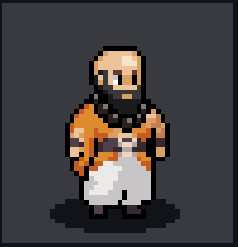 Crap, what does a monk even look like… Maybe I should hit the library… But that might be stereotyping… ah screw it, bald dude with a beard it is. – The Developer
Crap, what does a monk even look like… Maybe I should hit the library… But that might be stereotyping… ah screw it, bald dude with a beard it is. – The Developer
Name: Monk
Role: Tank
Analysis: Although badged by the game as a support, Monk is a tank in most compositions – he’s a melee with decent defensive stats and a defensive ability. Said ability heals himself plus one ally, with a fairly short cooldown; it’s not going to out-heal a damage dealer, but it’ll help to keep them alive a little longer. His ult is poorly worded in-game, but gives a shield to all allies in a radius around him, with affected allies gaining movement speed for the duration.
Monk excels in the early 2v2 format, where he can be paired with a damage dealer to fill a dual role of tank and off-healer. Unfortunately this format does not last very long, and with its exit, Monk quickly loses relevance. There’s no point at which he becomes utterly useless – he’s always going to be a fairly durable frontline unit that can give durability to other frontline units – but his kit simply gets outclassed. That said, if all the other tanks are picked or banned, he can still do the job.
Counters: None
Countered by: None
Suggested comps: Swordsman & Friend
Champions (cont.)
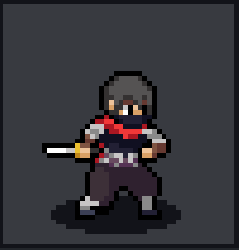 He’s so cool, with his swishy cape and bad boy attitude… – Every animé fangirl
He’s so cool, with his swishy cape and bad boy attitude… – Every animé fangirlName: Ninja
Role: Assassin
Analysis: Initially the only assassin available, and even after others get unlocked he remains the definition of the role. He’s very squishy, does a lot of damage, and his ability teleports him to the lowest health enemy (typically a backliner) and does a lot of damage to them. His ult creates a clone of himself; the two of them casting their abilities simultaneously basically guarantees death to whatever hapless fool they decide to target. The clone’s health decays over time, but plenty of damage is usually done in the meantime – and you can always draft a healer to support him so that the clone can continue to get work done.When you want a backliner deleted, call Ninja. No other champion does that job as reliably or as effectively. He lacks the gimmicks of the other assassins, certainly, but this simply makes him streamlined for the task at hand. Ninja basically never loses relevance unless chain-nerfed, so be ready to pick him if the opponent drafts a lot of squishy backliners.
Counters: Low-mobility squishies – Priestess and Sniper in particular.
Countered by: Knight (if alone), multiple sources of healing. AoE can also cockblock his ult pretty hard.
Suggested comps: Feed The Ghost, Split Map
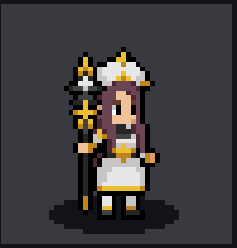 I may be a generic champion with a generic kit and a generic name, but I have a cooler hat than any of you! – Priestess
I may be a generic champion with a generic kit and a generic name, but I have a cooler hat than any of you! – Priestess
Name: Priestess
Role: Healer
Analysis: The archetypal healer, Priestess has zero offensive capability but instead provides significant healing and protection to her team. Importantly, her heal takes the place of her basic attack, so attack speed boosts such as Gale are very effective on a Priestess. Her ability grants a shield to an ally which also boosts their attack speed; generally this boost is hard to really notice unless cast on herself or a very high damage auto-attacker like Ninja. The shield is the important component, and simply works to further her goal of protecting her allies.
Her ult creates a zone of healing which can often outpace the damage dealt by multiple other champions; if positioned correctly it can swing an entire fight in your favour. That said, it can also be utterly worthless if mispositioned or if countered by burst (e.g. Sniper ult). Irrespective of this, however, it doesn’t really affect Priestess’ role.
Priestess is an extremely potent champion, but with notable counters. She can fit into most team comps, since most champions get a lot stronger when they don’t die (go figure). Her healing has a range limitation, however, so she can struggle to keep up with dive-focussed assassin comps – and she’s equally very vulnerable to being dived herself, lacking any kind of self-peeling ability (or indeed, robust defences). Even if her diver can’t kill her outright, it can ensure that she spends all her time healing herself instead of her allies, so always make sure that your comp has answers for diving enemies (or ban them out).
Finally, note that while she’s a strong healer, she can’t keep an entire team alive by herself – it’s entirely feasible for her healing to simply be overwhelmed, so don’t expect her to grant immortality to your team unless you won the draft in a lot of ways.
Counters: Low damage comps (e.g. comps running things like Icemage, Shrine Maiden, Barrier Mage), Ghost (since if it can’t kill anything, it stays weak).
Countered by: Heavy dive, especially Ninja, AoE (which can easily overwhelm her healing).
Suggested comps: Basically any comp that can use a healer wants Priestess in that role.
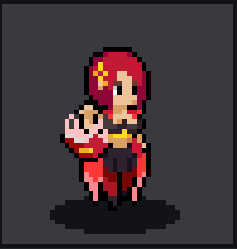 I’m just saying that maybe an outfit comprised of billowing silks is not appropriate when your entire skillset is indiscriminate arson. – Author
I’m just saying that maybe an outfit comprised of billowing silks is not appropriate when your entire skillset is indiscriminate arson. – Author
Name: Pyromancer
Role: AoE mage
Analysis: The queen of blasting melees, Pyromancer’s basic attacks deal damage to everything in a radius around her target. Her ability creates a small zone on the floor which attacks any enemy within it (with the same AoE potential as her own attacks), while her ult creates a much larger zone, dealing continuous damage to any enemy within it.
Pyromancer is, alone, the reason why melee-heavy comps tend to perform poorly in this game. Although her attacks don’t tend to hit as many targets as Lightning Mage – her main competition for the AoE crown – she tends to do noticeably more damage to whatever she does hit, particularly if her ability gets positioned nicely. She’s also no slouch in single-target damage, so she can be a fairly flexible pick; her main weakness is her range, which puts her at a disadvantage when fighting other ranged champions.
Pyro can usually be picked in pretty much any comp as a flexible addition, but you should usually try to wait until the opposing team picks at least two melee before doing so. That said, the AI doesn’t have too much respect for her ability to nuke melees, and will often pick a second melee even after you lock her, so don’t worry too much about it.
Counters: Any comp with more than one non-assassin melee.
Countered by: Assassins, long-range damage dealers, Barrier Mage (to an extent)
Suggested comps: Cleave
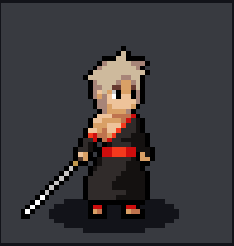
Name: Swordsman
Role: Bruiser
Analysis: There’s a reason that Swordsman’s face is the icon for the game. It’s because Swordsman basically defines the early game. Before any patches are introduced, Swordsman rules the roost with his combination of decent defensive stats and high damage. He’s a simple champion – his ability is simply ‘more melee damage’, and his ult is ‘some more damage, but with a dash this time!’. Simple, yes, but very effective in the 2v2 bracket where you need champions to fill multiple roles (where at least one of those roles is usually ‘damage’).
Even after the format moves to 3v3, Swordsman can retain a role if supported in melee by a partner. He does not function well when alone on the frontline, however. Far more importantly, he’ll likely be nerfed for several patches in a row after you start a game, usually targeting his damage – and Swordsman without damage is nothing.
In the first season, he’s definitely going to be pick/ban (unless the game has some form of new game stat randomisation I’m not aware of, anyway). In the second season he’ll usually still be pretty high priority. Be ready to transition away however – Swordsman does not fare well in the final 4v4 format, particularly since this will be after several unfavourable balance changes.
In the unlikely event that Swordsman makes it through to 4v4 relatively unscathed by patches, he’s mostly going to be a niche pick; he lacks the survivability to cope with the increase in damage floating around in a larger format, and so will only be picked in melee-centric comps. That said, he will remain the premier melee damage dealer for those situations.
Counters: Pretty much all other melee in an isolated fight.
Countered by: Fighter (to an extent; Fighter’s ability can lock him down enough for a second damage dealer to kill him), AoE (in melee comps).
Suggested comps: Swordsman & Friend, Bash Bros
Champions (cont.)
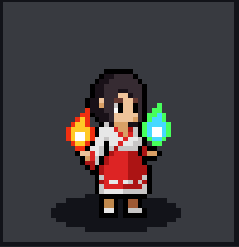 Cake or pie… cake or pie… Oh, I just can’t decide… Uhhh… Pie! Wait, but.. sweet or savoury… um… – Shrine Maiden
Cake or pie… cake or pie… Oh, I just can’t decide… Uhhh… Pie! Wait, but.. sweet or savoury… um… – Shrine MaidenName: Shrine Maiden
Role: Support
Analysis: A strange champion, Shrine Maiden is the game’s definition of ‘jack of all trades, master of none’. Unlike the other notable hybrid champion, Devil, Shrine Maiden’s kit simply isn’t good enough in any one area to make her a good draft; certainly in my main playthrough at present she’s received five back-to-back buffs and still isn’t really viable.Shrine Maiden’s attacks simultaneously damage enemies and heal allies; her ability picks an ally, heals them, and causes AoE damage around them at the same time. In both cases, however, the numbers are low enough that she’s unlikely to accomplish anything of note. Her ult creates a shrine which fires lots of projectiles very rapidly, some healing allies and others damaging enemies – again, the numbers are so low that this ult winds up being mediocre at best despite being visually impressive.
In theory, Shrine Maiden should fill the niche of ‘healer you take if Priestess is banned’. In practice, however, she’s almost never as good of a pick as simply bringing more damage. The only thing to say in her favour is that she does pack a reasonable amount of AoE, making her a possible option for Cleave comps that need some sustain (because of a late Ghost draft, for example).
Counters: None
Countered by: None
Suggested comps: None
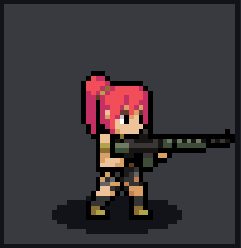 Private, I appreciate the effort with the camouflage hot pants and all, but it’s the pink hair that’s the real issue here. – Sniper’s commanding officer
Private, I appreciate the effort with the camouflage hot pants and all, but it’s the pink hair that’s the real issue here. – Sniper’s commanding officer
Name: Sniper
Role: ADC
Analysis: Sniper is the first new champion to be introduced to the game, and she certainly makes a splash upon arrival. She has arguably the best single-target damage in the game, with an ability which amounts to ‘Swordsman, but ranged’, and an ult which creates a circle and then deletes everything in that circle that she doesn’t like (not quite, but you get the picture; there’s only so many times I can say ‘deals damage’ before getting bored).
In the smaller formats, Sniper’s unparalleled damage output can actually compete with Swordsman’s dominance; however, her lack of mobility or self-peel makes her very vulnerable to assassins. She also has an annoying tendency to get stuck on tanks, and while she has good damage output, she’s still not going to kill a Knight or Shield Bearer particularly quickly.
Overall, Sniper fits into a pleasant niche; pick her when you need single-target damage and the enemy comp lacks the tools to shut her down.
Counters: Bruiser-healer combos (can usually outdamage the healing if it isn’t a dedicated tank)
Countered by: Assassins
Suggested comps: Paint-By-Numbers
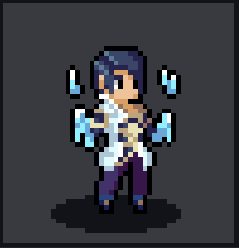 Ice is truly, truly, truly outrageous. – Icemage
Ice is truly, truly, truly outrageous. – Icemage
Punk-ass poser with his all-one-word name, who does he think he is, grumble, mutter… – Author
Name: Icemage
Role: Control Mage
Analysis: Icemage is the first of the game’s dedicated controllers, pairing lacklustre damage output with a basic ability which damages and stuns a single target, leaving them vulnerable to being picked off by other damage dealers. His ult creates a large circle, dealing damage over time to any enemy within it and stunning them if they’re still in the circle when it expires.
Release Icemage is too weak to see any play; although a control mage is desirable in the early 3v3 meta, his initial damage output is simply too low to make him effective. He’ll usually be buffed pretty quickly, though, and it only takes one or two buffs to make him effective in his role – shutting down divers.
Icemage is ineffective as a solo backliner – he lacks the damage output to be a real threat. He excels at protecting other backliners, however, by stunning diving assassins long enough for his allies to kill them. He should be paired with a ranged damage dealer and avoided in other comps – while it may be tempting to draft him with a Priestess, you’ll find that he lacks the damage to kill anything diving onto her, succeeding in nothing more than delaying the inevitable.
Additional note – Icemage has the most annoying name in the game. We have a Lightning Mage and a Barrier Mage… why does Icemage have to be an all-one-word hipster? This alone is enough to make me hate him.
Counters: Assassins (if supported by other damage)
Countered by: High damage output from the enemy team
Suggested comps: None
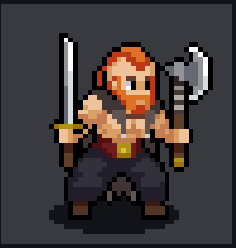 YARRRRRRGHGBLGBLGBLGBL – Berserker while ulting.
YARRRRRRGHGBLGBLGBLGBL – Berserker while ulting.
YARRRRRRGHGBLGBLGBLGBL – Everything Berserker hits while ulting.
Name: Berserker
Role: Bruiser
Analysis: As a bruiser reliant entirely on basic attacks, Berserker has a few key weaknesses. He has no active ability; instead, his base stats increase passively as his health drops lower. He also gains some lifesteal when below 40% (you’ll know when it triggers by the changed sound effect).
Berserker’s base kit is fairly weak; the stat gain and lifesteal don’t really do enough to make him powerful in melee, and he’s crippled by an extremely low movement speed. His ult, however, is phenomenal – he gains massive amounts of every stat, including speed, while also growing larger for the duration. It’s fairly common for an ulted Berserker to lawnmower through an enemy team one after another. Given his otherwise fairly poor performance, however, you’ll need to be sure that the swing from his ult will be enough to justify his inclusion.
Berserker pairs very well with Plague Doctor – he already gains stats from losing health, so Plague Doctor’s ability – lowering his health to give him extra stats – gives him enough overall to actually become a threat. This gives rise to the Bash Bros comp discussed in the comps section.
Berserker also has some notable counters – in particular, Lightning Mage’s ult can entirely shut down Berserker’s ult, entirely negating his main point of power. Necromancer is also a soft counter, as if Necromancer is able to raise him, the clone will usually immediately ult – not only probably wiping the team, but also using the kit’s built-in lifesteal to negate the decay effect.
Overall, then, Berserker’s kit simply has too many weaknesses to make him a staple pick – but situationally, if you can get the right comp together, he can be a powerhouse.
Counters: Low damage comps
Countered by: Burst damage, CC, Lightning Mage, Necromancer
Suggested comps: Bash Bros, Pain Train
Champions (cont.)
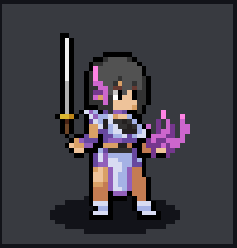 Yes, it is entirely necessary for my technique to levitate my sword instead of hitting things with it. No, it is not “just showing off”. Stop asking. – Magic Knight
Yes, it is entirely necessary for my technique to levitate my sword instead of hitting things with it. No, it is not “just showing off”. Stop asking. – Magic KnightName: Magic Knight
Role: Bruiser
Analysis: Although slotted into the Bruiser category, Magic Knight is far more of the Swordsman school of thought than the Fighter one – she cares about dealing damage first and everything else a distant second. Her ability deals decent damage in a narrow cone directed at her current target (in theory this can hit multiple targets, but this seems to be fairly rare). Her ult creates a gravity well on the ground, pulling enemy targets towards it periodically and dealing damage.As a low durability, high damage melee, Magic Knight suffers from a lot of the same issues which plague Swordsman and other low-utility melees. Once the game progresses to its 4v4 format (which will be shortly after her release), there’s simply too much damage around for her to reliably perform. She’s particularly vulnerable to AoE, and even under optimal circumstances – lots of squishy enemy melee – she doesn’t perform as well as a dedicated AoE mage. She ends up landing in the very situational ‘pick if you want a lot of melee’ category alongside Swordsman – and as that situation is extremely rare, don’t expect her to see a lot of play.
Counters: Clumped enemy melee
Countered by: AoE, damage in general
Suggested comps: Pain Train
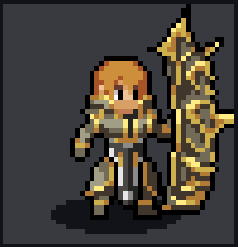 Um, guys? Are they over there? How about now? I really need to buy a stepladder for this thing… – Shield Bearer
Um, guys? Are they over there? How about now? I really need to buy a stepladder for this thing… – Shield Bearer
Name: Shield Bearer
Role: Tank
Analysis: When all you need is a brick wall for the enemy to have to punch through, look no further than Shield Bearer. For most of the game she performs one function, and only one function – eating damage while steadfastly refusing to die to it. Her ability causes her to passively redirect a proportion of damage dealt to allies nearby to herself, making her extremely well-suited to melee comps; however, her extremely high HP and good defence make her a great pick for a solo tank even if you have nobody to share the frontline with her. Her ultimate causes her to gain a lot of defence while also taunting every enemy in a wide area into attacking her, giving her allies free reign to return fire.
Shield Bearer, much like Knight, is an auto-pick if you need a tank for your composition. The choice between the two pretty much boils down to whether you need Knight’s taunt to peel assassins off your backline – if you don’t, Shield Bearer fits the role better, given that she’s tankier and has a more impactful ult.
Counters: Low damage comps, front-to-back comps, AoE (to a very limited extent – more of a band-aid than field surgery!)
Countered by: Attacks bypassing the frontline
Suggested comps: Paint-By-Numbers, Cleave, Front-To-Back
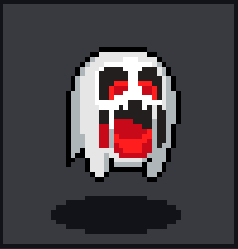 Note to self – insert obligatory Ghostbusters reference here. – Author
Note to self – insert obligatory Ghostbusters reference here. – Author
Name: Ghost
Role: Assassin
Analysis: One of the more unique champions in the game, Ghost is entirely unable to receive any beneficial effects from allies, has no ult, and has terrible base stats. However, after killing (or assisting in killing) an enemy, it gains a stack of a permanent buff; each stack increases its attack damage and attack speed. It also heals a small amount when gaining a stack. Its ability causes it to become untargetable while moving quickly to a low health enemy.
For obvious reasons, an unchecked Ghost is an absolute nightmare to deal with which can quickly snowball out of control and (literally) devour entire teams. However, it’s pretty easy to shut it down – due to its terrible starting stats, a single Priestess can negate a Ghost for much of the game, and Icemage can also do a good job of rendering Ghost’s attempts to dive the backline futile.
Due to this reliance on stacking, Ghost should never be picked without becoming the centrepiece of your team. Your comp should be designed around ensuring that Ghost gets stacked as quickly and safely as possible, transforming it from a liability into a carry. For a summary on how to do this, see the Feed The Ghost comp below.
Note – while Ghost will play the ‘nom’ animation when killing Necromancer minions, it doesn’t get a stack from doing so. It does, however, become happier. That’s binge-eating culture for you.
Counters: Everything if fed
Countered by: Healers, CC, everything if not fed
Suggested comps: Feed The Ghost
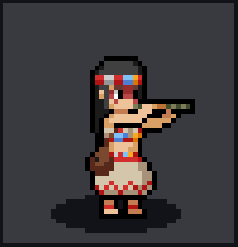 She may be underpowered, but those substances make for some killer after-match parties… – Author
She may be underpowered, but those substances make for some killer after-match parties… – Author
Name: Poison Dart Hunter
Role: ADC
Analysis: Poison Dart Hunter (which is a pain to type out; hereafter abbreviated in this entry to PDH) is an ADC centred around damage over time; her basic attacks, ability and ult all add a periodic damage effect to enemy champions. Her ability does so by creating a zone on the ground, poisoning any enemy to enter it; her ult adds the effect to all allies’ basic attacks for a short period.
Unfortunately, this periodic damage is not particularly high, and as ability damage numbers aren’t affected by patches, this basically never changes. While in theory PDH can put out a lot of damage (and indeed, this sometimes even happens in practice), that damage is often spread out across a lot of enemies and rarely translates into quicker kills. Damage that doesn’t lead to a kill is worthless in a game entirely determined by kills; as such, PDH starts out extremely weak and doesn’t get much better with buffs.
That said, the one thing PDH can do is counter Vampire pretty effectively. Vampire heals a lot slower in his coffin when receiving damage, and if he’s poisoned, he’s going to be receiving that damage constantly. Of course, to make this relevant, the opponent has to first draft a Vampire, and you then have to actually be scared of it – a combination of events which is fairly rare.
Counters: Vampire
Countered by: Healing
Suggested comps: None
Champions (cont.)
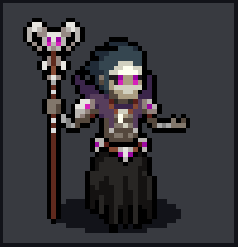 That Priestess looks pretty cool. Mind if I… borrow her for a while? – Necromancer
That Priestess looks pretty cool. Mind if I… borrow her for a while? – NecromancerName: Necromancer
Role: Control Mage
Analysis: Now we’re talking. Necromancer is an extremely potent champion who can fit into a lot of different comps due to his flexibility, utility, and potentially gamebreaking ult.Necromancer’s base damage output is fairly low. His ability, however, creates a ghoul which acts as a melee unit (and, unlike most similar effects, is not subject to decaying health). The ghoul does respectable damage, though is fairly squishy, and remains on the field until killed. This means that if the enemy does not draft a way to deal with them efficiently (read: take an AoE mage) then the ghoul onslaught will, at very least, soak substantial amounts of damage and skills that would otherwise be hitting your frontline; under optimal circumstances, ghouls will survive long enough to start stacking up, at which point the Necromancer’s combined damage output becomes very high.
However, it’s the Necromancer’s ult which is the most compelling part of the kit. When cast, a clone of the most recently killed enemy is spawned next to the Necromancer; although subject to decaying health, this clone has all the stats and abilities of its counterpart – and most importantly, has access to their ult! This basically means that Necromancer’s ult becomes ‘one of the enemy’s ults, plus a chunk of stats for a while’, which is ludicrously good. Even in the worst case you’re going to wind up with a decent frontline tank to soak for a while (allowing ghouls to stack up); best case, you’re getting an ulted Berserker to go wipe the enemy team.
Necromancer’s kit supports a wide variety of comps, as well as having some ludicrously good potential outcomes when ults start rolling out, so you can slot him into most teams. However, he’s at his best when paired with a Priestess – giving healing to the decaying ult-minion can give you a permanent numbers advantage, which is particularly impressive when you manage to steal an enemy Devil!
N.B. I class Necromancer as a control mage, since the most reliable part of his kit is the utility provided by the ghoul swarm; however, he can reasonably be called a single-target damage dealer as well.
Counters: Anything with a high-impact ult, low damage teams
Countered by: AoE
Suggested comps: Pretty much anything that needs a backline damage dealer/controller combo
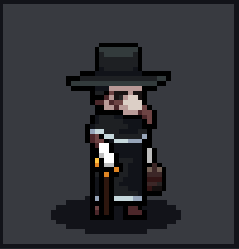 It’z gonna hurt a lot but you’ll be betta… you’ll see… heheheheheh… – Mad Dok Plague Doctor
It’z gonna hurt a lot but you’ll be betta… you’ll see… heheheheheh… – Mad Dok Plague Doctor
Name: Plague Doctor
Role: Support
Analysis: Plague Doctor brings with him the unappealing combination of low base stats with a melee body; however, his abilities are potent enough to make him a niche pick in spite of this. As a firm believer in the adage ‘you have to be cruel to be kind’, his ability deals damage to nearby allies; however, in return, it gives them a decent boost to attack damage, attack speed and movement speed. His ult doubles down on this, reducing all allies to 1 HP and giving substantially greater benefits, with the added bonus of making them immortal for the duration.
Plague Doctor would be very, VERY weak if not for the power of his ult – frankly, this lasts longer than good game balance would dictate, often allowing a team to wipe our their opponents once, and then again on the respawn, before expiring. Of course, it does have the side effect of likely guaranteeing their death once it expires, but this is a small price to pay for absolute domination in the meanwhile.
Even with it, however, Plague Doctor is crippled by being melee. His stats are nowhere near high enough to let him survive melee combat with most champions for any extended period, and he’ll also die quickly whenever a ranged damage dealer decides to pick on him. If you’re going to draft him, you’ll need to make sure you get your money’s worth out of his abilities – and you can do this by drafting Berserker (who likes everything Plague Doctor is dishing out, including the damage), and Priestess (to heal allies back up, particularly during/after his ult). These three units together combine to form the Bash Bros comp below, which can then be easily expanded into a Pain Train comp if desired.
Counters: Low damage/speed allies, ult-centric comps (as his immunity can often make enemy ults entirely wasted)
Countered by: CC during his ult, basically everything that hits him
Suggested comps: Pain Train, Bash Bros
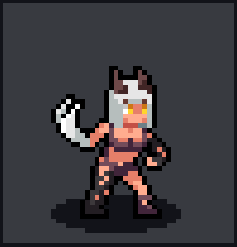 No, I’m not a succubus! IF YOU LIVED IN HELL YOU’D DRESS LIGHT TOO! – Devil
No, I’m not a succubus! IF YOU LIVED IN HELL YOU’D DRESS LIGHT TOO! – Devil
Name: Devil
Role: Hybrid
Analysis: Devil has a kit which defies categorisation, leading her to be the only champion I mark Hybrid. She also quickly defines the metagame on release, in my view, immediately becoming pick/ban until nerfed. Although badged by the game as an assassin, she really doesn’t function as one, so disregard that categorisation for everything except stat boosts.
Although defined as an assassin, she lacks their tendency to attempt to dive the backline where possible. However, her ability causes her to swap places with the furthest enemy target – which usually means alternating between swapping a backliner into your frontline (which, in turn, puts her in range of the other backliners), and swapping a melee into the backline (which takes her out of dive position). This is why she’s not an assassin despite finding herself hitting backliners often (and also why she’s very powerful). Note that enemies are rooted for a few seconds after being swapped, and due to some slightly dodgy targeting mechanics, they often stand around doing nothing for that time even if there’s an enemy in range.
Devil’s ult, however, is what makes her impossible to categorise. Upon being cast, she gains a significant stat boost and her basic attacks become ranged – and this state lasts indefinitely until her death. Given the defensive stat boost it provides and her tendency to swap herself out of danger regularly, she can fairly reliably retain this form for the entire fight if provided some healing, meaning from halfway through the game she can be thought of as a major single-target damage dealer rather than anything else!
Despite an impressive kit, Devil does have a few vulnerabilities – essentially, anything that can reliably kill her after she ults. Berserker and Plague Doctor ults will do this pretty much every time, but even disregarding them, she’s as prone to eating a random Sniper ult as anyone else is. On the other hand, her ability to swap backliners into the melee makes her a soft counter to most ranged champions – and in particular, to Vampire, whose coffin gets swapped into melee, making him easy pickings.
Due to her awkward categorisation, Devil doesn’t really fit into any specific comp. Instead, she’s a situational pick that you should keep in mind for drafting whenever the enemy doesn’t seem to have anything that can deal with her. She’s equally good at messing with backliners as assassins, and can even hold her own in melee (until nerfed, of course). The only real recommendation to make is to pair her with Priestess wherever possible, to ensure you get the most value out of her ult.
Counters: Vampire, any champion that wants to stay at a particular range
Countered by: Big ults
Suggested comps: None
Champions (cont.)
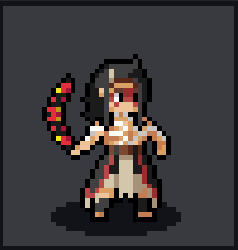 Yes, this is definitely how boomerangs work. Especially my ult. Honest. – Boomerang Hunter
Yes, this is definitely how boomerangs work. Especially my ult. Honest. – Boomerang HunterName: Boomerang Hunter
Role: ADC
Analysis: Another ADC, Boomerang Hunter has deceptively poor base stats – ‘deceptively’ because he’s actually surprisingly good. His basic attacks pass through their target, dealing damage to all enemies hit, and then return to him – so while his attack damage looks low, it in fact applies twice to his primary target and can also apply to other nearby enemies. His range is also fairly low, but again, this only applies to his initial target – he has to be fairly close to start attacking, but those attacks travel further, potentially hitting enemies farther away.Boomerang Hunter’s ability, though confusingly worded in-game, is fairly simple – he throws a projectile to a fixed point, damaging anything it hits on the way. It then spins in place for a few seconds, dealing damage over time and reducing the defence of any enemies hit. Although not incredible, its fixed range means it has a tendency to hit medium-range backliners behind the frontline, which can be valuable when paired with other AoE. His ult, meanwhile, is extremely simple – for a few seconds he deals significant damage over time in a moderately-sized area around himself.
Easy to underestimate, the Boomerang Hunter can easily become a staple of many comps. He won’t ever reach the same single-target damage output that Sniper, or even Archer, can put out (short of significant patch intervention, at least); this isn’t his niche. However, any time he can hit more than one target with his attacks, he’ll suddenly be putting out more damage than either of them. Furthermore, his ult is a lot more reliable than most, as being both damage-over-time and centred on Boomerang Hunter it’s quite difficult to miss.
He can be slotted into many comps as a flexible choice, but is most at home in a Cleave comp, replacing – or more likely, filling in for after a ban – Pyromancer or Lightning Mage.
Counters: Melee-heavy comps, short-ranged backliners
Countered by: Long-ranged backliners
Suggested comps: Cleave
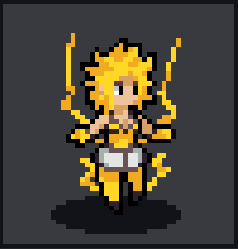 Do you know what happens to a toad when it gets hit by lightning? – The single worst writer in Hollywood
Do you know what happens to a toad when it gets hit by lightning? – The single worst writer in Hollywood
Name: Lightning Mage
Role: AoE Mage
Analysis: The last of the truly staple picks to be released, Lightning Mage is very short-ranged and has fairly low attack damage. She compensates for this by virtue of her basic attacks chaining to other nearby targets – although still not incredible, the chaining effect has a greater range than Pyromancer’s AoE, and will often manage to chain to the backline if there’s at least one short-ranged damage dealer around.
Lightning Mage’s ability is fairly underwhelming, being very similar to Icemage’s – she deals damage to a single target while also stunning it, though in her case the stun is very brief (to the point that you could be forgiven for not noticing it). Her ult, on the other hand, is far more impressive – she targets an enemy and stuns it, dealing damage over time to it and all other nearby enemies, and won’t stop casting until they die. Note that while the damage chains to other enemies, the stun does not – don’t expect to stunlock an entire team with this.
Lightning Mage tends to be a slightly more reliable, but also more vulnerable, choice for an AoE mage compared to Pyromancer. Her attacks are much more likely to catch backliners while targeting frontliners, and due to not being centred on a single location don’t tend to whiff quite as often due to targets spreading out. However, her range is significantly lower, leaving her in the firing line if her frontline goes down. Her ult is also one of the few things that can counter Berserker or Plague Doctor ults, making her valuable as a counterpick to them as well.
On the whole, as an AoE mage, Lightning Mage can be picked into any comp as a flexible addition and is perfectly at home in a Cleave comp. However, try not to take her as a solo damage dealer – unlike Pyromancer she lacks the firepower (pun unintended but welcomed) to kill single targets with any degree of efficiency.
Counters: Comps with mixed ranges, melee comps, Berserker, Plague Doctor
Countered by: Pyromancer (she often wanders close enough to be caught in the AoE)
Suggested comps: Cleave
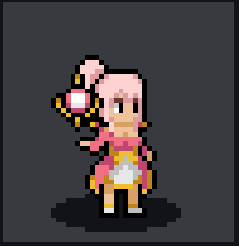 Okay, fine, I’ll deal with the bubblegum hair, but do I really have to wear this ridiculous outfit? Do I at least get a transformation sequence? – Barrier Mage
Okay, fine, I’ll deal with the bubblegum hair, but do I really have to wear this ridiculous outfit? Do I at least get a transformation sequence? – Barrier Mage
Name: Barrier Mage
Role: Support
Analysis: ‘Hey guys’ I said. ‘What if you took Priestess, put all her power into her ability, and then made it so that ability could miss or be badly positioned?’
‘Well, that would be terrible’ you quite reasonably say. And you are entirely correct.
Barrier Mage brings to the table a low damage ranged basic attack and an ability which creates a zone on the ground. Allies who are in this zone when it’s cast (or who enter after the fact) will gain a shield; enemies within the zone find their attack speed slowed. Her ult creates a much larger zone, within which enemy projectiles cease to exist.
Let’s be fair here – Barrier Mage’s ability is pretty good if it hits properly. Giving a shield to multiple allies while also shredding enemy attack speed is a strong effect. Unfortunately, it does have a failure rate – she targets an ally, but that ally can easily be one who’s under no threat or is advancing towards the enemy, leading them to immediately walk out of it. The rest of her kit, meanwhile, is extremely weak and contributes very little to a fight.
As a result, there is basically no comp I can recommend Barrier Mage as an addition to unless she gets repeatedly buffed (and even then, it’d need to be her ability cooldown, not her damage). Her absolute best use-case would be as the last pick when both teams have 3-4 melee – which basically never happens – and even then, any of the three major AoE champions are going to get more done.
Note – this does not mean to say that Barrier Mage is useless, and in fact, if most of her casts go off successfully then she’s really quite effective. The problem is that your draft should prioritise reliable execution, so any draft that includes a champion with a failure rate should generally be avoided.
Counters: AoE (to a very limited extent)
Countered by: None
Suggested comps: None
Champions (cont.)
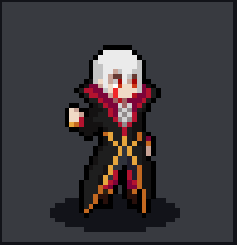 Yes, he looks scary, but remember – he’s more scared of you than you are of him. – Author
Yes, he looks scary, but remember – he’s more scared of you than you are of him. – AuthorName: Vampire
Role: Assassin
Analysis: In theory, Vampire is a very resilient assassin who leaves behind permanent bleed effects to hinder enemies he doesn’t successfully kill. In practice, however, this resilience comes at the cost of his uptime, leading him to spend more than half of most fights sat on his backside watching everyone else fight.Vampire’s ability creates a coffin automatically as soon as he spawns. This coffin can be attacked as though it were a minion, and if it’s destroyed, so is Vampire. If he falls low in health, he will retreat to the coffin, wherein he will heal up (while crying and reading Anne Rice novels).
The unfortunate reality, however, is that he’s very squishy and where other assassins will pick up a kill and then die, Vampire will fail to pick up a kill and then run away. The time taken to heal is substantially longer than the time it would take to respawn – increased even more if he takes damage while trying to heal – leading to him spending inordinate amounts of time doing absolutely nothing.
The rather confusingly-worded Vampire ultimate appears to be a passive which creates a permanent bleed effect on a target after he hits them for the 13th time. This is actually surprisingly effective, and if he manages to get this bleed applied to multiple targets he can put out some impressive (if often irrelevant) damage numbers. The odds of this happening before he once again flees to hide are pretty slim, though, particularly given his low base stats. It should also be noted he has built-in lifesteal, though his low health and damage on release render this an afterthought at best.
In general, then, Vampire should usually be disregarded as a core pick – his best case scenario is on the upper end of OK, and he rarely gets there. He can perform fairly well against low damage backlines, however, where he’s able to stack up his bleed and start taxing the healers/supports, and can be a decent partner for Ghost when he’s not napping.
Counters: Priestess (to a very limited extent, by stacking bleeds)
Countered by: Devil (teleports his coffin into a vulnerable location), pretty much all decent damage dealers, AoE hitting his coffin
Suggested comps: Feed The Ghost
Team Comps
The following are basic, generic ideas for team comps that can work (but don’t always work!). The main intent here is to give you examples of overlapping synergies that can be exploited, allowing you to better understand them so as to make your own comps. Don’t follow anything here line by line – your game will differ from mine, and what works for me won’t necessarily work for you.
The following is the template I will be using for my analysis of each team comp:
Name: Again, it’s just the name. What do you want from me, dude?
Suggested champions: The list of champions that fit into the comp. Note that often there won’t be a full four champions listed – the core comp is usually smaller, allowing you to pick flexibly for the last slot based on what your opponent has picked. If a champion is underlined, they’re core to the comp (or I really like them, I guess).
Playstyle: How the comp tends to work.
Good against: What the comp works into, and therefore when you should pick it.
Bad against: The inverse of the above.
Bans: My suggestion as to bans to throw out if you’re planning on using this comp – mostly to prevent the opponent from countering you.
 Name: Swordsman & Friend
Name: Swordsman & Friend
Suggested Champions: Swordsman, Monk, Fighter
Playstyle: This comp is only relevant during the early 2v2 format, but it pretty much beats all other comps during that time. Release Swordsman is all kinds of busted; this comp simply pairs him with another melee who can soak damage for him and allow him to keep doing his job. Make sure you ban Pyromancer (who will be hitting both of them); your second ban depends on Swordsman’s partner. Ban Archer if you’ve got Monk, as he can’t close with her effectively enough; ban Ninja if you’ve got Fighter, as Ninja’s ability hits hard and will deal a lot of damage over time.
Note – while I say this is only relevant in 2v2, it can transition to 3v3 by adding a single ranged damage-dealer or Priestess and perform acceptably well. Performance varies based on how badly Swordsman got nerfed.
Good against: Basically everything else in 2v2
Bad against: Basically everything in 4v4
Bans: Pyromancer, Archer/Ninja
 Name: Paint-By-Numbers
Name: Paint-By-Numbers
Suggested Champions: Sniper, Necromancer, Archer, Knight, Shield Bearer
Playstyle: Paint-By-Numbers aims to combine multiple sources of single-target damage to nuke down individual targets one at a time. It’s a good pick against opponents that rely on healers, as lots of single-target damage will overwhelm healing and allow you to pick up kills. It falls apart if disrupted, or if your frontline collapses too quickly; because of this, Knight becomes a good choice for your frontline. You will usually want a single frontline, and either three single-target DPS or two plus a Priestess.
Good against: Comps with lots of squishy melee, single assassins (as they get nuked down before they can land a kill)
Bad against: Multiple assassin comps, anything with backline access (Devil in particular), Tank + Priestess combos. Ninja can also one-shot your backliners depending on how buffed/nerfed he is.
Bans: Ninja, Devil
 Name: Front-To-Back
Name: Front-To-Back
Suggested Champions: Priestess, Barrier Mage, Shrine Maiden, Knight, Shield Bearer, Sniper
Playstyle: A very defensive comp and the distant cousin of Paint-By-Numbers, this setup relies on creating an impassable wall of meat and shield that the enemy simply can’t get through. Combine a heavy tank with Priestess and either Shrine Maiden or Barrier Mage and it’ll take a substantial amount of firepower for the enemy to get through; a single damage dealer can usually net you significantly more kills than the enemy can score.
Assassins will entirely negate this comp, given they’ll bypass your steel frontline to stab at the fleshy underbelly of your healers. Comps with very high damage output can also sometimes simply overwhelm your healing. Aim for this comp when your opponent likes to pick low damage backliners like Icemage, Shrine Maiden or Poison Dart Hunter.
Good against: Low damage comps
Bad against: Assassins, high damage output
Bans: Any and all assassins.
 Name: Feed The Ghost
Name: Feed The Ghost
Suggested Champions: Ghost, Ninja, AoE
Playstyle: The name of the comp is also fairly descriptive of its function – the purpose of this comp is to ensure that your Ghost gets multiple stacks as early as possible, allowing it to snowball and dominate a game. Ninja is usually the best partner for your Ghost, doing enough damage to set up Ghost stacks (though be careful – depending on attack and defence levels, it’s not uncommon for Ninja to simply steal all the kills for himself and leave the Ghost to starve).
If the opponent drafts multiple melees – usually a way to soft counter assassins – you can compensate by drafting AoE. A Pyromancer and/or Lightning Mage will often drop enemy champions low enough that Ghost can simply walk (or, I suppose, float) down the line, eating one at a time.
It is important, however, to bear in mind Ghost’s limitations – don’t bother drafting healers or buffers. They’ll help the rest of your comp, but that’s not what you’re trying to do here. Focus on setting the Ghost up for success, and it’ll carry you to victory. You hope.
Good against: Squishies
Bad against: Comps with multiple healers/supports, CC
Bans: Priestess, Icemage, Archer
Team Comps (cont.)
 Name: Split Map
Name: Split MapSuggested Champions: Two backline divers, two self-sufficient ranged. Devil can fill either role.
Playstyle: This is a comp I’ve had some limited success with but have struggled to make work reliably. The premise is that you split the map (as the name implies) – your backline gives their frontline the runaround while wearing them down, and your assassins dive the enemy backline and butcher them.While the comp works well in theory, it has multiple points of potential failure – your backline needs to be able to kite the enemy melee for an extended period without either killing them or dying to them, allowing your divers to kill off the enemy squishies multiple times, and your divers need to be able to re-engage after being killed by respawns without becoming de-synced. If the stars align, however, the comp not only works well, but also leaves you feeling like a genius.
Good against: Single-target backliners, slow melee
Bad against: Comps with heavy melee or ranged bias, champions with mobility abilities
Bans: Usually whichever assassins you’re not using, or Icemage/Archer if you’re not using them.
 Name: Cleave
Name: Cleave
Suggested Champions: Pyromancer, Lightning Mage, Priestess, Knight, Shield Bearer
Playstyle: A pretty stable core composition which I’ve had a lot of success with, this comp has three roles. It needs a tank – Shield Bearer if the enemy has no assassins, Knight if they have one. It needs an AoE mage – Pyromancer if the enemy has lots of melee, Lightning Mage if they don’t. And it needs a healer – Priestess irrespective of anything else, because nobody else can heal as effectively as her.
Your fourth slot is a flexible one and can be used to provide additional support to your frontline (via Shrine Maiden or Barrier Mage), additional AoE if the opponent has three or four melee (via whichever AoE mage you didn’t take already), peel for your backline via Icemage (if combined with Knight can entirely shut down single assassin comps), or just add on some general purpose damage and utility via champions like Necromancer or Devil. Personally I tend towards the latter unless given a good reason to do otherwise.
While most champions can slot into the flex slot and be effective, you should generally try to avoid diving assassins, as they’re usually left to operate outside the safety of your Priestess and can provoke the enemy into splitting up, negating your AoE. The sole exception to this is Devil, who can provide access to enemy backliners that the comp otherwise lacks, and becomes a ranged damage dealer later into the fight anyway.
Good against: Most things
Bad against: Multiple assassins, very high single target damage to nuke your solo tank
Bans: Ninja, one other assassin.
 Name: Pain Train
Name: Pain Train
Suggested Champions: Shield Bearer, melee
Playstyle: This comp is basically just a walking death star of concentrated pain. The concept is simple – draft four melee and let them gang up on anything they manage to get into range of. It’s easily countered, but fortunately, there are only two major counters (which fits nicely with the number of bans you have).
The main issue, aside from the obvious AoE, is that the AI likes to pick melee too. If you can pull together the melee you want, it works great; if you’re having to pick up scraps, it won’t be anywhere near as effective. The comp also struggles against multiple enemy ranged champions if they spread out. It does, however, entirely counter assassins, who tend to dive in and immediately die to four angry men and women turning on them in an instant.
The lynchpin of the comp is Shield Bearer, who is both very tanky (enabling her to soak damage for your other melee), and also soaks that damage for them whether they like it or not. She should be backed up by at least two other melee – not assassins, you don’t want your group splitting up – at least one of whom brings decent damage output (i.e. Magic Knight, Swordsman if he somehow got this far without being nerfed into irrelevance).
The fourth slot is somewhat flexible, and can fit a healer (if the enemy doesn’t draft assassins) or a self-sufficient damage dealer like Icemage or Archer. Situationally, Barrier Mage can be a good draft (her shields work well for clumped fights). Alternatively, Shield Bearer combined with the Bash Bros comp below work as an excellent Pain Train comp.
Good against: Other melee-heavy comps, short-ranged or low-mobility backliners
Bad against: AoE
Bans: Pyromancer, Lightning Mage. If the AI is nice enough to ban one of these for you, Boomerang Hunter is third on the priority list.
 Name: Bash Bros
Name: Bash Bros
Suggested Champions: Berserker, Plague Doctor, Priestess
Playstyle: Berserker and Plague Doctor have great synergy, as discussed in their individual entries. It’s a no-brainer to then combine them with Priestess to negate the main disadvantage of Plague Doctor’s inclusion (aside from his relatively weak statline, anyway). These three champions can work great as a unit, or you can add in a Shield Bearer to create a Pain Train.
Good against: Tanks, low damage comps.
Bad against: AoE
Bans: Pyromancer, Lightning Mage.
Comps to avoid
Much as the above are some general comps you can run with various modifications, there are certain team setups you should tend to avoid, either because they’re prone to being countered or they simply under-perform.
Melee-heavy
With the exception of the few melee comps listed above, most melee-centric comps do not work. The keen-eyed reader will note that there are a lot of champions I list above that perform well into melee, far too many to easily ban them all. The AI falls into this trap often – but you’re smarter than the AI. Right? ..R-right, guys? Assuming you are, draft a maximum of two melee (usually only one) unless you’re banning smart, running a heavily synergistic comp, and the meta favours you.
All Dive All Day
I know, I know, assassins are annoying and they murder your backline every game. So drafting 3-4 assassins should be broken, right? Unfortunately not. As well as being annoying, assassins tend to be extremely squishy and usually pretty stupid – they’ll dogpile on the lowest health target even as they get blasted by two other squishies. Assassin-heavy comps are also one of the few things that melee-heavy builds perform well into, since you can’t stab a squishy if there is no squishy to stab. The most you’ll want to run is two (and even then, only if you need a dive buddy for Ghost).
Melee is for Chumps
I’ve spent a lot of this guide talking smack about melee, so why not just cut them out entirely? This can actually work to an extent, but only to an extent; in theory, if properly spread out and with good kiting, an all-ranged comp would work like a charm. In practice, however, players tend not to be that smart. In the majority of games, a comp with one melee and three ranged will outperform a comp with four ranged, if only by virtue of the melee taking significantly longer to kill than its counterpart does.
These Guys Are OP, Right?
As I go into a little more in the Drafting and Stats Analysis sections, there’s more to life than winrates (a lesson a lot of gamers should learn in a more general sense, frankly). Going in with a list of the top eight champions – and picking the top four of those that aren’t banned – won’t work a lot of the time. You’ll probably be picking four champions with no real synergy or interplay simply because in entirely different circumstances they performed well.
To give a more easily followed example – let’s say comps with any three champions, plus one assassin, are winning 100% of games. If the specific assassin doesn’t matter, and the rest of the champions don’t matter so long as there’s three of them, then you’ll see all of the assassins at the top of the winrate board. But picking all of them in one comp disregards the way they got to the top of the leaderboard, ensuring a quick loss.
The one exception to this rule is when you’re utterly dominating the season and tend to use one comp above all others – there’s a good chance that the four champions that make up your comp will sit at the top of the leaderboard because you put them there. In that case, just keep picking them – if it ain’t broke, right?
Recruitment
There are five tiers of recruitment, and each has a specific purpose; having said that, three of them become obsolete pretty quickly.
1. Local Talent
This option is fast, cheap, and generally worthless except right at the beginning of the game. It’ll find low-grade players who can do well in the amateur league but are outclassed everywhere else. Recruit a couple of these when you start your playthrough, then avoid like the plague.
2. Scout Dispatch
Still fast, cheap and generally worthless, but better than Local Talent. It’ll give you players with decent enough stats to compete in the Semi-Pro League, but still get outclassed everywhere else. If you’re good enough at drafting, you can probably avoid this one in favour of option #3.
3. Rising Star
Here’s where things get a little more interesting. The players recruited through this method are about the same, skill-wise, as those recruited through option #2 – but they’re younger. This gives them better stat increases from training, and a longer period to train before they start to get old and slow. As a general rule, it seems to take 2-3 seasons of training before these guys can compete in the top league, and they’re unlikely to ever excel – but they will be effective for longer than option #4 players will.
4. Veteran
These players come to you already solid – they’ve got the skills to compete in the top division, and usually some pretty good experience on champions too. On the other hand, they won’t ever excel, and due to being fairly old they’ll very quickly reach the point where training won’t improve their skills (and instead just slow their decline). If you get promoted back-to-back you’ll need to recruit a few of these to hold the line, since your option #3 players won’t be good enough yet. Note that as they’re well established career players, they’re pretty pricey to recruit.
5. Super Rookie
These guys make option #3 players obsolete, as they’re the same but better in every way. They start at higher skill levels, and they come even younger – allowing them to learn faster and learn longer. Once you hit the top division (and can afford to do so), you’ll want to recruit at least four of these guys to sit on your benches for a few years; eventually they’ll be able to compete with the other players in your league, while still having room for more growth. Long-term, they’ll become the best players the world has ever seen – you just have to get them there.
Recruitment (cont.)
Being the astute intellectual powerhouse you surely are, reader, you’ll have noticed that two of these options are ‘growth’ options – players who you recruit on the premise that they’ll be useful further down the line. What kind of players, then, are you looking for, given you won’t know what the meta looks like in the future?
Excellent question, reader (I knew you were a smart one). Bearing in mind that for both classes of player, recruits start with only one champion mastered, the answer becomes clear. For Rising Star players, you should generally disregard their champion options in favour of simply ensuring they don’t have awful traits. The simple fact is that you won’t be using them for all that long anyway, and it’s really not worth spending a lot of money to find the right Rising Star when you could be spending that money on much more important things, like facility upgrades, hookers and blow (coming soon in a future update, I hope).
Super Rookies, on the other hand, are the players of your future. You’re going to be investing a lot of time into these guys (or to be more accurate, spending a lot of money on them while they sit around wasting your time). You want to make sure you’re getting your money’s worth, inasmuch as you’re ever going to.
Start, then, by recruiting any Super Rookies you can with acceptable traits (I’ll go into this in the Traits section). Disregard their starting champion – if it’s decent, good, if not, they have three more rolls to get something decent. As soon as they’re hired, put at least four training points into ‘New Champion’, and give them a week. They’ll pick something up at random (we really need better communication in this organisation) – make sure you remember to swap the points from that champion back into ‘new champion’ – so repeat the process. Continue until they have all four of their champions mastered, then reconsider them.
As a rule, you’ll want every player to have at least one versatile, splashable pick in his mastered champions list. That means a tank – Knight or Shield Bearer really – a damage dealer (preferably an AoE one, or at least Necromancer), or a Priestess. This will mean that in the majority of games, they’ll have something to do. They should also have at least one pick which is viable, but potentially niche – Ninja, Devil and Sniper are good examples of this. Any other champions they pick up that are viable are an added bonus; if they don’t meet this minimum requirement, drop them and look for another.
Don’t be concerned at this point if your players pick up overlapping champions, so long as those overlaps happen on versatile picks; for example, I have three players capable of playing Necromancer, but he’s strong enough and fits into enough comps that I’m fine with that. I can pick him pretty much any time and be guaranteed that he’ll go to someone who can use him well.
Once you’ve got some Super Rookies following the above guidelines… well, get more! Once you get to that point you shouldn’t have too many things to spend your money on anyway, so you may as well draft a broad roster for later on. Once they eventually come of age (figuratively speaking) you can pick your favourites and let the others go, keeping one or two as bench-warmers in case you need a change of strategy.
Finally, 2-3 seasons after you’ve recruited these guys, do another recruitment exercise and pick up some additional talent. Your new all-stars aren’t going to live forever, after all, and when they’re all doddering old men (read: 25 or older) they’re going to need to be replaced – and you can’t sit around waiting for new Super Rookies to train up while your senile pensioners ruin your perfect track record, can you now?
Player Traits
There are, as you’ll know or quickly learn, various traits that players can have when recruited. In a lot of cases, these traits are functionally irrelevant once you get into the later stages – a small stat boost until the first kill amounts to virtually nothing in the grand scheme of a game – but there are certain ones to keep an eye out for, for better or worse:
Despise Weakness / Collaboration Attack
These traits both tend to look great on paper, but are traps. They force specific targeting – the former targeting enemies that have recently been attacked, the latter the lowest health enemy. The issue is that these players are entirely single-minded about their desired targets, to the extent of being complete morons about it.
Yes, it’s a nice thought to give your Despise Weakness player a Ninja so he can go off and one-shot the Priestess. That’s cool. Trouble is, he was going to do that anyway – all you really did was ensure that at some point during the fight, he’s going to lose interest in beating on the healer because the enemy Shield Bearer finally went down to 10% health, so now he’s haring off across the battlefield to go poke her armoured buttocks.
Far more importantly, however, these traits force you into specific comps. If one of your players has Despise Weakness, you can essentially never run a comp that doesn’t include an assassin, because trying to have that player run a long-ranged damage dealer simply ensures that they’ll faceplant the melee and die repeatedly. Similarly, Collaboration Attack locks you out of using assassins entirely, and can also result in your frontline abandoning their post to go chase a Devil around the map.
But let’s say you’re stuck with these players for a while, for one reason or another. How do you cope? There are two ways, really, aside from simply picking the appropriate comps for them and letting them have their way. The first is to put them on a Priestess – thanks to her not having a basic attack, she prevents them from doing anything stupid. The second, much more long-term-viable method, is to keep them on the bench in favour of another player and bring them out periodically when you want to run the comp they work in. It’s not as much of a problem to be forced into running assassins if you’re only forced in that direction every other game, after all.
Coward / Competitive
Broadly the same as Despise Weakness / Collaboration Attack above, cowards run away unless they have a buddy to hold their hand, while competitive players will chase whoever’s lived for the longest time. Unlike the above, there is no real functional use-case for these players; avoid them at all costs.
Gale / Thorn / News of Victory / Smell of Blood / Quick Cast / Clutch Hitter / Piercing Spear
These are all fairly generic, positive-only traits which you should look for in recruits wherever possible. There are small champion-specific benefits to them – Quick Cast is worthless on Berserker, for example, while News of Victory and Smell of Blood are nice for Ghost players – but overall the effect is fairly minimal either way. Nice to have, but don’t go out of your way to get them.
Relief Pitcher
I’ve seen some confusion over this trait, so let me quickly explain – if you start a match with a player with this trait in your team, they get worse. If you bring them in later – i.e. they don’t play set 1, but play a subsequent set – they get stronger. Something of a no-brainer, then, to keep them on the bench until you need them.
Various morale traits
These can vary from good to bad, but aside from Pessimist (which should be avoided) they can all generally be ignored.
Sponsors
Very brief section to talk quickly about sponsors – specifically, to talk about what to avoid. Unless you’re completely outclassing your league, always try to avoid any sponsor that asks you to maintain massive winstreaks or get >650 kills in a season – frankly, these things are difficult and at times beyond your control, and you don’t want one unfortunate loss or a meta shift towards low-kill games to cost you a lot of money. Instead, prioritise sponsors who:
- Ask you to run specific champions. Often these champions are viable anyway, so you can get your sponsorship money for doing very little. Even when they aren’t, they track individual picks, so they’re easy to complete – if you win the first game in a match, pick all of the champions your sponsor wants in the second game. If you lose, you can pick up the win in the third game by playing normally – and either way, you get at least three picks towards your sponsor’s goal.
- Ask you to avoid dying <650 times. This is a lot easier than picking up huge kill numbers, and frankly even in a bad season I’ve never had more than 650 deaths. As a general rule of thumb, you’ll probably die ~20-25 times in most losses and ~10-15 times in most wins, so use that to estimate how often you’ll probably die based on your strength in the league.
- Avoid loss-streaks. This is riskier than the other two and should usually be a last resort, but it’s a lot more within your control than the other options are – you can have a winstreak broken by one unlucky match, whereas a long loss streak requires… well, several unlucky matches.
Okay, here is where things get a little more complicated. But you made it this far, reader, so I’ll assume you’re probably not a dummy (or you’re a dummy with an above-average attention span; either way, kudos). Nonetheless, I will go into some basics of information analysis. Notably, while the game is deficient in a lot of aspects, one thing it is very good at is giving you a lot of statistical information from which to draw conclusions on the metagame, so learning to do this properly can give you a significant advantage over your AI rivals.
The starting point for your analysis should be the Champion Statistics panel. Before we even get started on the information within, you should consider where it’s coming from – this information is only from games played this season and in your league (or, if you’ve made it there, during Worlds). It won’t tell you anything about other leagues, nor anything historically (which is a good thing, as it prevents outdated data from skewing the results). The biggest weakness of the data as provided is that it doesn’t allow any filtering for the mid-season point – there’s a patch after the first half of the season which can drastically change the power levels of champions as listed.
Now then, to the data. Champions are helpfully listed in order of winrate (although it would be much more helpful to let you change the listing, but let’s not dwell on that for now). While useful as a quick-and-dirty, at-a-glance, I-need-more-hyphens analytical tool, winrate doesn’t tell you everything. It can be skewed by various factors such as variable comps being built around single champions, several AI teams making the same drafting error (making assassins seem more powerful than they are, for example), or a single team dominating and making their go-to comp look good.
Let’s take a look at an example, shall we? Here’s a cut of data from one of my ongoing games, showing only the top and bottom performers:


So, what can we learn from this data? The first thing I note is that the pick and ban counts are very low – this means this data cut was taken very early on in the season (in fact, after just two matches – the numbers imply to me that the game treats 2:0s as three set matches, with nothing picked in the third set). Having identified this, we should resolve to take everything here with a pinch of salt; two matches is generally not enough to build a solid statistical framework around. We can get a rough idea of how things are going, though.
First let’s consider the top performers. We can see Lightning Mage, Priestess, Knight and Boomerang Hunter all in the top four – the makings of a good Cleave comp – while Pyromancer is nowhere to be seen. Why is this? There are a lot of reasons this could be, but in actual fact it’s again a symptom of the data set being so limited – in both of the matches I’ve played at this point, I stomped the opposition with that exact Cleave comp, and Pyromancer has been banned each time. My dominance to this point has caused my chosen comp to skew in the ratings significantly.
Also notable is Vampire’s presence in the top champions list – not necessarily bizarre in itself, but note his Damage Dealt total. As a general rule, a damage dealer needs to put out around 1200 damage to reach an ‘acceptable’ figure in each set; the fact that he’s doing this well with only 642 average damage per set is confusing. We’ll have to see what’s going on there later.
Now let’s consider the bottom figures. A lot of the champions here are no great surprise, the information in the Champions section above having indicated that a lot of these picks are on the weaker side (you did read that section, right?). There are two notable surprises however – Archer and Shield Bearer.
Archer appears here to be performing acceptably on the damage numbers, but still losing. Given she also has a decent enough KDA, it would be a reasonable inference to suggest that she’s just being picked by relatively weak teams up to this point, and her stock will rise in future. This is pure guesswork at this stage, however.
Shield Bearer, meanwhile, has an average Damage Taken figure of 3120 – this is really quite impressive, as a Tank should usually soak about 2400 damage to be performing well in my experience. She’s still losing though – I wonder why?
Due to the limited data there aren’t many conclusions I can draw here – only that Cleave is working for me and I should keep running it.
Data Analysis (cont.)


We can see that the Cleave comp champions are still performing well – this is not a surprise to me, as I’m 9-0 at this point in the season and have been primarily running that comp. The pick-or-ban rate, however, indicates that I’m not the only one to have noticed this – the AI is also using these champions frequently, and to great success. I can infer that the AI will be banning these champions with some regularity, and I’ll have to be ready to pivot where necessary. I also note that Boomerang Hunter has dropped off, possibly because the AI has stopped banning Pyromancer quite so much so I’m able to take her instead.More surprisingly, Plague Doctor is currently sitting at #5. Why this is happening is unclear – his numbers are on the low end of mediocre, but frankly that’s always going to be the case for Plague Doctor. Hmm. Vampire is also still sitting in the upper tiers despite continuing to put out garbage tier numbers – I’m still really unclear what’s happening here.
Turning our attention to the lower end of the table, we can see that our guess about Archer was entirely correct – she’s risen out of the depths. Shield Bearer, however, continues to underperform for unclear reasons. It could also surprise some to see Sniper dropping to the lower tiers, but I’m aware that she’s been chain-nerfed for a few patches and so is presumably finally hitting her resting point.
My conclusions at the midpoint are that Cleave is going to be heavily contested from this point on, and I should think about pivoting to a different strategy while letting the AI ban itself out. A viable option appears to be a Bash Bros comp, since Plague Doctor is performing well.
Data Analysis (cont.)


Not a lot of change at the very top of the table, but we do see Boomerang Hunter has returned, most likely a result of increased ban priority on Pyromancer and Lightning Mage, while the latter pair have seen a slight drop in winrate as the meta adapts to their dominance. Plague Doctor has also fallen in the standings, while Archer completes her redemption arc by finishing in the upper part of the standings.You’ll note that I didn’t pivot away from Cleave in the end – my three losses were partially the result of experimentation with other comps which wound up backfiring. A return to the winning formula worked out fine, though, albeit with a fair amount of Necromancer needing to be splashed in (accounting for his placement in the upper tiers by the midpoint of the season).
In the lower part of the table, Vampire finally takes his expected place (I still have no idea how his winrate stayed so high for so long), and Shield Bearer escapes the shame of a bottom-half finish. Shrine Maiden has risen drastically in the standings, possibly due to ban pressure on Priestess, and her place has been filled by a newly arriving Magic Knight. I’m quite unclear on why Magic Knight wasn’t already this low, as she does not perform well in a Cleave meta – possibly the AI simply started picking her for some reason.
One final note for this last section of screenshots – The extremes of the table have been narrowing for the entire season (i.e. the best-performing champion has lost winrate and worst-performing has gained winrate). This is expected in any even vaguely healthy metagame, and you’ll typically see winrates normalise to an extent across any given season.
Some final notes on the data analysis side, continuing to use the end-season data:
- Note how poor Ghost’s stats are, and in particular, his phenomenal amount of damage taken. This is partially explained by his innate healing (he’ll tend to heal himself and therefore be able to eat more damage before dying), but more than anything is the result of the assassin tendency to dive backlines until they die. Not seen in the screenshots, Ninja has similar damage taken numbers. Bear this tendency in mind when evaluating assassin performance, but note you should still expect at least ~1000 damage per game from an assassin performing their job correctly (this is lower than a general purpose damage-dealer’s damage numbers, as assassins don’t have any tanks to smack around to inflate their numbers).
- As in most games, KDA is pretty much irrelevant. It doesn’t matter how good your KDA is if you can’t translate that into game wins. Barrier Mage’s 4.16 KDA demonstrates this admirably.
- I was able to track down the reason for Shield Bearer’s early underperformance – she was the favourite pick of two of the lower-ranked teams who had fairly poor players on their roster. Bear in mind that the option to drill down to granular-level detail exists – go to Team Statistics and you can look at each individual team to see their match record (including picks/bans) and winrates with each player playing each champion.
- If you’re not dominating your league, it’s recommended to check your opponent’s most frequently played/banned champions before each game so that you know what kind of playstyle they tend towards. If they play something you can easily counter, leave their champions open and let them have what they want.
Drafting Hints & Tips
A few scattered hints and tips for better drafting below, mostly because they don’t fit anywhere else.
- Don’t put too much weight on the champions your players are good at. Bonus Attack and Defence are nice, but they’re not going to make a bad pick into a good one. Instead, identify the strong champions (or, y’know, read that part of the guide) and try to acquire players that are good on those champions. The be all and end all is, comp trumps player skill at all times.
- Learn to identify when champions are pick/ban. This is fairly common with new champions – to a greater or lesser extent, Sniper, Ghost, Necromancer, Devil and Lightning Mage are all pick/ban on release – but can easily arise due to misguided buffs or a specific metagame existing. To give an example, in my current playthrough Pyromancer has received back-to-back unjustified buffs every patch for two seasons and now outputs comparable single target damage to Sniper. She’s pick/ban for that reason – there is no better backline damage source right now – and all the more so because the AI keeps picking 2+ melee into her.
- On a similar note, identify when champions stop being pick/ban. Nerfs are the most obvious reason this happens – but think critically about a nerf when it happens. Did the change actually hurt the champion all that much? If Lightning Mage’s ability cooldown gets nerfed, it really doesn’t weaken the champion much at all – you’re picking her for her AoE basic attacks, not her frankly fairly mediocre ability.
- If a certain champion gives you no end of trouble, and you can’t seem to create a good comp to abuse it yourself, there’s no shame in banning it whenever you’ve got one free. I’ve done this fairly regularly with Ghost and Plague Doctor, simply because they have a nasty habit of pulling wins together from terrible comps through random chance. Just don’t cripple a comp you’re trying to put together if you desperately need those bans to prevent counters.
- Remember that if you’re first pick, you can treat that pick as an extra ban if you need to. Just make sure the champion is good enough to be worth picking, and you’ve got options for comps to run around it.
- By contrast, the advantage of picking second is having two picks together – you can pick up combinations of champions that individually tend to underperform, like Berserker and Plague Doctor, without risking them being stranded.
- If you run the same comp over and over again, the AI will notice and try to pick/ban those champions away from you, particularly if you’re finding success with them. This isn’t a problem if you know how to beat it and the AI doesn’t, but can be problematic if you’re abusing very strong champions that you can’t turn the tables on. To avoid this problem, periodically swap from one comp to another to wrongfoot the AI.
- Further to the above, it can be beneficial to maintain at least a small stable of alternate players. This is a great use for players with otherwise irritating traits (I’m looking at you, Collaboration Attack/Despise Weakness) – you can swap them in for one game at a time to run strategies that aren’t crippled by their traits, then swap them back out to return to your usual comp.
- If all else fails, go into the team statistics, look at the match record for the top team in your league, and try to copy what they’re doing. It’s not a great strategy since the AI can often be questionable, but if you’re constantly losing and can’t seem to find your feet, it may give you a starting point at very least.
- Not really about drafting, but as an additional note – if you really want to min/max, bear in mind you get paid on a per-game basis. Since playoffs are done on a gauntlet basis, that means you’ll get more money for winning the league if you finish the regular season in 4th or 5th, since you’ll have more games to play to win. Of course, given the substantial payout for winning the league vs just playing games, this is only recommended if you’re very confident.
That’s everything from me. I hope this wall o’ text has helped in some way. Please let me know your experiences in the comments below – I will look to update this guide going forward based on community feedback.


Wow what an immense help for fellow min-maxers :^) But seriously now: This guide is awesome! Since the game gained a bit of new traction in early 2022, this is great to get a clue how to survive the Pro Division and beyond.